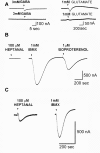The location of olfactory receptors within olfactory epithelium is independent of odorant volatility and solubility
- PMID: 21548958
- PMCID: PMC3118157
- DOI: 10.1186/1756-0500-4-137
The location of olfactory receptors within olfactory epithelium is independent of odorant volatility and solubility
Abstract
Background: Our objective was to study the pattern of olfactory receptor expression within the dorsal and ventral regions of the mouse olfactory epithelium. We hypothesized that olfactory receptors were distributed based on the chemical properties of their ligands: e.g. receptors for polar, hydrophilic and weakly volatile odorants would be present in the dorsal region of olfactory epithelium; while receptors for non-polar, more volatile odorants would be distributed to the ventral region. To test our hypothesis, we used micro-transplantation of cilia-enriched plasma membranes derived from dorsal or ventral regions of the olfactory epithelium into Xenopus oocytes for electrophysiological characterization against a panel of 100 odorants.
Findings: Odorants detected by ORs from the dorsal and ventral regions showed overlap in volatility and water solubility. We did not find evidence for a correlation between the solubility and volatility of odorants and the functional expression of olfactory receptors in the dorsal or ventral region of the olfactory epithelia.
Conclusions: No simple clustering or relationship between chemical properties of odorants could be associated with the different regions of the olfactory epithelium. These results suggest that the location of ORs within the epithelium is not organized based on the physico-chemical properties of their ligands.
Figures




Similar articles
-
Salamander olfactory bulb neuronal activity observed by video rate, voltage-sensitive dye imaging. III. Spatial and temporal properties of responses evoked by odorant stimulation.J Neurophysiol. 1995 May;73(5):2053-71. doi: 10.1152/jn.1995.73.5.2053. J Neurophysiol. 1995. PMID: 7542699
-
Tests of the sorption and olfactory "fovea" hypotheses in the mouse.J Neurophysiol. 2017 Nov 1;118(5):2770-2788. doi: 10.1152/jn.00455.2017. Epub 2017 Sep 6. J Neurophysiol. 2017. PMID: 28877965 Free PMC article.
-
Spatially organized response zones in rat olfactory epithelium.J Neurophysiol. 1997 Apr;77(4):1950-62. doi: 10.1152/jn.1997.77.4.1950. J Neurophysiol. 1997. PMID: 9114247
-
Olfactory receptor function.Handb Clin Neurol. 2019;164:67-78. doi: 10.1016/B978-0-444-63855-7.00005-8. Handb Clin Neurol. 2019. PMID: 31604564 Review.
-
Anatomical contributions to odorant sampling and representation in rodents: zoning in on sniffing behavior.Chem Senses. 2006 Feb;31(2):131-44. doi: 10.1093/chemse/bjj015. Epub 2005 Dec 8. Chem Senses. 2006. PMID: 16339266 Review.
Cited by
-
Investigations and Outcomes for Olfactory Disorders.Curr Otorhinolaryngol Rep. 2022;10(4):377-384. doi: 10.1007/s40136-022-00438-x. Epub 2022 Nov 29. Curr Otorhinolaryngol Rep. 2022. PMID: 36465666 Free PMC article. Review.
-
A 3D transcriptomics atlas of the mouse nose sheds light on the anatomical logic of smell.Cell Rep. 2022 Mar 22;38(12):110547. doi: 10.1016/j.celrep.2022.110547. Cell Rep. 2022. PMID: 35320714 Free PMC article.
References
LinkOut - more resources
Full Text Sources

